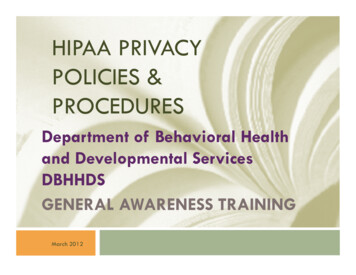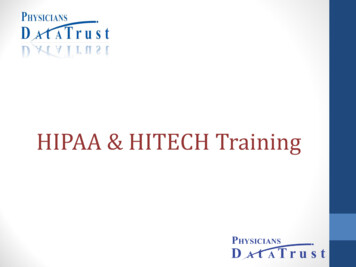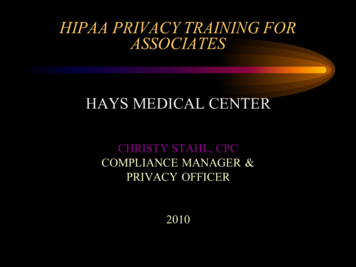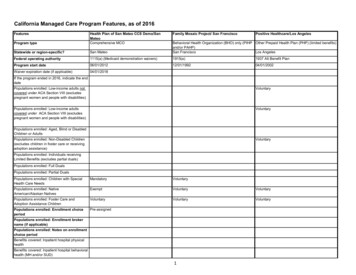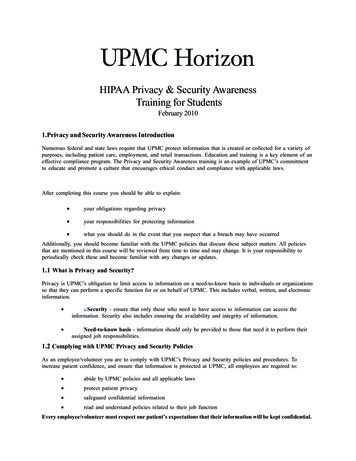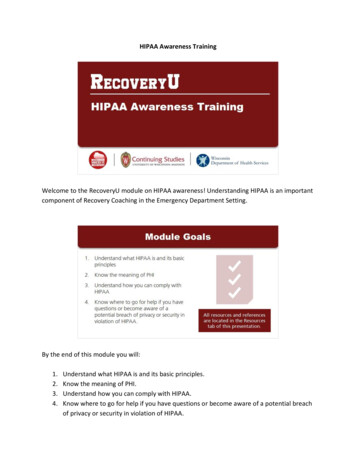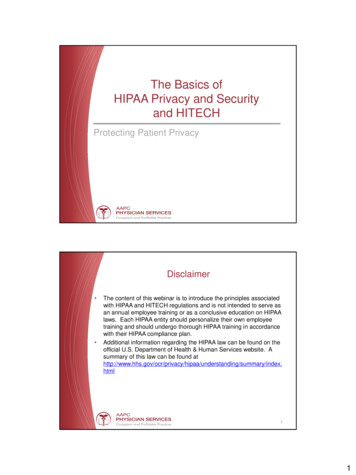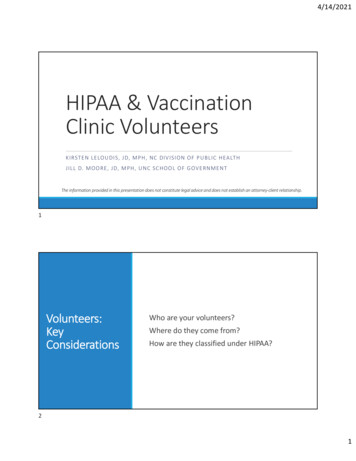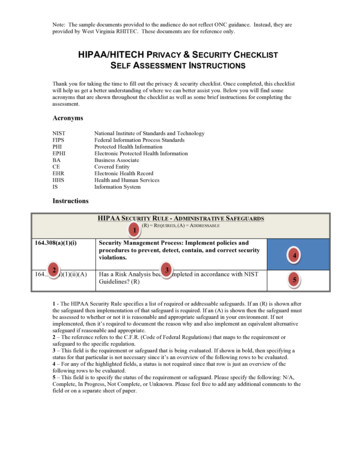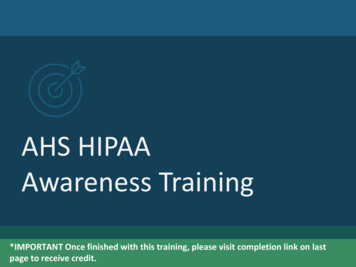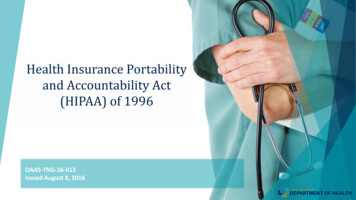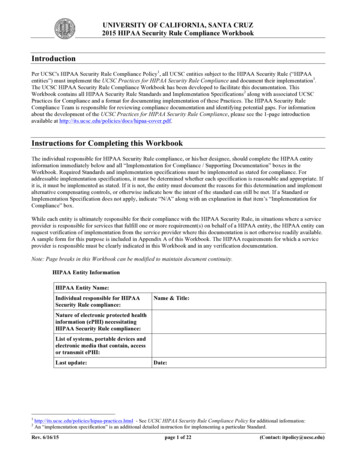
Transcription
UNIVERSITY OF CALIFORNIA, SANTA CRUZ2015 HIPAA Security Rule Compliance WorkbookIntroductionPer UCSC's HIPAA Security Rule Compliance Policy1, all UCSC entities subject to the HIPAA Security Rule (“HIPAAentities”) must implement the UCSC Practices for HIPAA Security Rule Compliance and document their implementation1.The UCSC HIPAA Security Rule Compliance Workbook has been developed to facilitate this documentation. ThisWorkbook contains all HIPAA Security Rule Standards and Implementation Specifications2 along with associated UCSCPractices for Compliance and a format for documenting implementation of these Practices. The HIPAA Security RuleCompliance Team is responsible for reviewing compliance documentation and identifying potential gaps. For informationabout the development of the UCSC Practices for HIPAA Security Rule Compliance, please see the 1-page introductionavailable at Instructions for Completing this WorkbookThe individual responsible for HIPAA Security Rule compliance, or his/her designee, should complete the HIPAA entityinformation immediately below and all “Implementation for Compliance / Supporting Documentation” boxes in theWorkbook. Required Standards and implementation specifications must be implemented as stated for compliance. Foraddressable implementation specifications, it must be determined whether each specification is reasonable and appropriate. Ifit is, it must be implemented as stated. If it is not, the entity must document the reasons for this determination and implementalternative compensating controls, or otherwise indicate how the intent of the standard can still be met. If a Standard orImplementation Specification does not apply, indicate “N/A” along with an explanation in that item’s “Implementation forCompliance” box.While each entity is ultimately responsible for their compliance with the HIPAA Security Rule, in situations where a serviceprovider is responsible for services that fulfill one or more requirement(s) on behalf of a HIPAA entity, the HIPAA entity canrequest verification of implementation from the service provider where this documentation is not otherwise readily available.A sample form for this purpose is included in Appendix A of this Workbook. The HIPAA requirements for which a serviceprovider is responsible must be clearly indicated in this Workbook and in any verification documentation.Note: Page breaks in this Workbook can be modified to maintain document continuity.HIPAA Entity InformationHIPAA Entity Name:Individual responsible for HIPAASecurity Rule compliance:Name & Title:Nature of electronic protected healthinformation (ePHI) necessitatingHIPAA Security Rule compliance:List of systems, portable devices andelectronic media that contain, accessor transmit ePHI:Last ractices.html - See UCSC HIPAA Security Rule Compliance Policy for additional information:An “implementation specification” is an additional detailed instruction for implementing a particular Standard.Rev. 6/16/15page 1 of 22(Contact: itpolicy@ucsc.edu)
UNIVERSITY OF CALIFORNIA, SANTA CRUZ2015 HIPAA Security Rule Compliance WorkbookTable of ContentsThis document is arranged by HIPAA Security Rule requirement. Each implementation specification (or Standard in theabsence of specific implementation specifications) is followed by practices for compliance, along with space to documentimplementation of the practices and list other supporting documentation.Introduction . 1Instructions for Completing this Workbook . 1HIPAA Security Rule: ADMINISTRATIVE STANDARDS . 3§164.308(a)(1)(i) - Security Management Process . 3§164.308(a)(2) - Assigned security responsibility . 4§164.308(a)(3)(i) - Workforce security . 5§164.308(a)(4)(i) - Information access management . 6§164.308(a)(5)(i) - Security awareness and training . 7§164.308(a)(6)(i) - Security incident procedures . 9§164.308(a)(7)(i) - Contingency plan . 9§164.308(a)(8) - Evaluation . 11§164.308(b)(1) - Business associate contracts and other arrangements . 12HIPAA Security Rule: PHYSICAL STANDARDS . 13§164.310(a)(1) - Facility access controls . 13§164.310(b) - Workstation use . 14§164.310(c) - Workstation security . 15§164.310(d)(1) - Device and media controls . 15HIPAA Security Rule: TECHNICAL STANDARDS . 18§164.312(a)(1) - Access Control . 18§164.312(b) - Audit controls . 20§164.312(c)(1) – Integrity . 20§164.312(d) - Person or entity authentication . 21§164.312(e)(1) - Transmission security . 21Rev. 6/16/15page 2 of 22(Contact: itpolicy@ucsc.edu)
UNIVERSITY OF CALIFORNIA, SANTA CRUZ2015 HIPAA Security Rule Compliance WorkbookHIPAA Security Rule: ADMINISTRATIVE STANDARDSSTANDARD§164.308(a)(1)(i) - Security Management ProcessImplement policies and procedures to prevent, detect, contain, and correct security violations.§164.308(a)(1)(ii)(A) - Risk Analysis (Required)Conduct an accurate and thorough assessment of the potential risks and vulnerabilities to the confidentiality,integrity, and availability of electronic protected health information held by the covered entity.Practices for Compliance Identify relevant information systems and electronic information resources that require protection. Conduct risk assessments to understand and document risks from security failures that may cause loss ofconfidentiality, integrity, or availability. Risk assessments should take into account the potential adverse impacton the University’s reputation, operations, and assets. Risk assessments should include backups and nonoriginal sources of ePHI. Review and update risk assessments every three years, or more frequently in response to significant legislative,environmental or operational changes. Inform the UC HIPAA Privacy and Security Official(s) of the completion of all documented risk assessmentswithin thirty (30) days of their completion, and provide a copy upon request.Implementation for Compliance§164.308(a)(1)(ii)(B) - Risk Management (Required)Implement security measures sufficient to reduce risks and vulnerabilities to a reasonable and appropriate level tocomply with §164.308(a).Practices for Compliance Select appropriate controls, e.g. policies, procedures, technologies, to safeguard data relative to the sensitivity orcriticality determined by the risk assessment, and document the party(ies) responsible for implementation ofeach recommended practice. Where possible, incorporate these Standards and practices when evaluating and selecting new hardware andsoftware.Implementation for ComplianceRev. 6/16/15page 3 of 22(Contact: itpolicy@ucsc.edu)
UNIVERSITY OF CALIFORNIA, SANTA CRUZ2015 HIPAA Security Rule Compliance Workbook§164.308(a)(1)(ii)(C) - Sanction Policy (Required)Apply appropriate sanctions against workforce members who fail to comply with the security policies andprocedures of the covered entity.Practices for Compliance Take disciplinary or other action in accordance with University personnel policies, bargaining agreements, andguidelines on workforce members who, in the course of their employment, fail to comply with University policyand procedures, including information security policy and procedures. (See Personnel Policies for UC StaffMembers (PPSM 62, 65, 67), UC BFB IS-3, applicable bargaining agreements, UC Academic PersonnelManual (APM 015, 016 & 150), and UCSC Campus Academic Personnel/Procedures Manual (CAPM 002.015& 003.150).) Ensure that documentation of violations and application of HIPAA-related sanctions is maintained appropriatelyand retained for six years.o HIPAA entities are responsible for informing Human Resources and/or Labor Relations whensubmitting documentation with this retention requirement.Implementation for Compliance§164.308(a)(1)(ii)(D) - Information system activity review (Required)Implement procedures to regularly review records of information system activity, such as audit logs, access reports,and security incident tracking reports.Practices for Compliance Regularly review information system activity and log-in attempts.o See UCSC's Log Policy and related Log Procedures at http://policy.ucsc.edu/policies/its/it0005.html Maintain documentation of periodic log reviews. Logs relevant to security incidents should be retained for six years and the remainder of the data should only beretained for up to 90 days in accordance with usual and customary practice. Define responsibility for information system activity review, including log-in monitoring and access reports.Implementation for ComplianceSTANDARD§164.308(a)(2) - Assigned security responsibilityIdentify the security official who is responsible for the development and implementation of the policies and proceduresrequired by this subpart for the entity.Implementation for ComplianceRev. 6/16/15page 4 of 22(Contact: itpolicy@ucsc.edu)
UNIVERSITY OF CALIFORNIA, SANTA CRUZ2015 HIPAA Security Rule Compliance WorkbookSTANDARD§164.308(a)(3)(i) - Workforce securityImplement policies and procedures to ensure that all members of its workforce have appropriate access to electronic protectedhealth information, as provided under paragraph (a) (4) of this section, and to prevent those workforce members who do nothave access under paragraph (a) (4) of this section from obtaining access to electronic protected health information.§164.308(a)(3)(ii)(A) - Authorization and/or supervision (Addressable)Implement procedures for the authorization and/or supervision of workforce members who work with electronicprotected health information or in locations where it might be accessed.Practices for ComplianceDetermine which individuals are authorized to work with ePHI in accordance with a role-based approach.Implementation for Compliance§164.308(a)(3)(ii)(B) - Workforce clearance procedure (Addressable)Implement procedures to determine that the access of a workforce member to electronic protected health informationis appropriate.Practices for Compliance Review role definitions and assignments for appropriateness at least annually. Review access management procedures for appropriateness at least annually.Implementation for Compliance§164.308(a)(3)(ii)(C) - Termination procedures (Addressable)Implement procedures for terminating access to electronic protected health information when the employment of aworkforce member ends or as required by determinations made as specified in paragraph (a) (3) (ii) (B) of thissection.Rev. 6/16/15page 5 of 22(Contact: itpolicy@ucsc.edu)
UNIVERSITY OF CALIFORNIA, SANTA CRUZ2015 HIPAA Security Rule Compliance WorkbookPractices for ComplianceEstablish account maintenance procedures that ensure termination of accounts or change in access privileges forindividuals who have been terminated or are no longer authorized to access ePHI.Implementation for ComplianceSTANDARD§164.308(a)(4)(i) - Information access managementImplement policies and procedures for authorizing access to electronic protected health information that are consistent withthe applicable requirements of subpart E of this part.§164.308(a)(4)(ii)(A) - Isolating health care clearinghouse functions (Required)If a health care clearinghouse is part of a larger organization, the clearinghouse must implement policies andprocedures that protect the electronic protected health information of the clearinghouse from unauthorized access bythe larger organization.Implementation for ComplianceN/A for UCSC§164.308(a)(4)(ii)(B) - Access authorization (Addressable)Implement policies and procedures for granting access to electronic protected health information, for example,through access to a workstation, transaction, program, process, or other mechanism.Practices for Compliance There must be a formal system for authorizing user access to ePHI, such as an account request form requiringmanagement approval. Access is to be granted in accordance with a role-based approach. Maintain documentation of all authorized users of ePHI and their access levels. Employees must receive security awareness and HIPAA training prior to obtaining access to ePHI. HIPAA systems must have the capacity to set access controls.Implementation for Compliance§164.308(a)(4)(ii)(C) - Access establishment and modification (Addressable)Implement policies and procedures that, based upon the entity’s access authorization policies, establish, document,review, and modify a user’s right of access to a workstation, transaction, program, or process.Rev. 6/16/15page 6 of 22(Contact: itpolicy@ucsc.edu)
UNIVERSITY OF CALIFORNIA, SANTA CRUZ2015 HIPAA Security Rule Compliance WorkbookPractices for ComplianceDevelop and implement procedures to establish, document, review and modify a user’s access to ePHI. Access shalluse the principle of “least privileges”. Procedures must ensure regular review of those with access to ePHI, including the appropriateness ofaccess levels. Procedures must require prompt initiation of account modifications/termination.Implementation for ComplianceSTANDARD§164.308(a)(5)(i) - Security awareness and trainingImplement a security awareness and training program for all members of its workforce (including management).§164.308(a)(5)(ii)(A) - Security reminders (Addressable)Periodic security updates.Practices for Compliance Establish security awareness and HIPAA training for all members of the UCSC workforce who are involved inthe creation, transmission, and storage of ePHI. Training activities include:o Initial security awareness and HIPAA training for individuals with ePHI-related job duties. Trainingwill include UCSC Password Standards and the importance of protecting against malicious softwareand exploitation of vulnerabilities.o Review of changes to internal policies, procedures, and technologieso Periodic reminders about security awareness and HIPAAo Security notices or updates regarding current threats HIPAA entities must maintain records of training materials and completion of training for six years.Implementation for Compliance§164.308(a)(5)(ii)(B) - Protection from malicious software (Addressable)Procedures for guarding against, detecting, and reporting malicious software.Practices for ComplianceTo protect all devices against malicious software, such as computer viruses, Trojan horses, spyware, etc., implementthe following. Also ensure the safeguards and configurations below are included in the standard set-up proceduresfor new systems and workstations that contain or access ePHI.Rev. 6/16/15page 7 of 22(Contact: itpolicy@ucsc.edu)
UNIVERSITY OF CALIFORNIA, SANTA CRUZ2015 HIPAA Security Rule Compliance Workbook Run versions of operating system and application software for which security patches are made availableand installed in a timely manner.Harden systems. “Hardening” includes:o Install OS and third party application updates (patches) and keep them currento Change or remove default logins/passwordso Disable unnecessary serviceso Install virus and malware protection software and update them at least weeklyo Set proper file/directory ownership/permissions; NTFS should be used on Windows servers andshared workstationsPeriodically, and at least annually, review HIPAA workstation browser settings to ensure that they complywith ITS' recommended browser security settings: e.html.Periodically, and at least annually, review email client settings to ensure they comply with current ITSrecommendations: l.Perform periodic network vulnerability scans of systems containing known ePHI, and workstations thataccess ePHI, and take adequate steps to correct discovered vulnerabilities.Implement e-mail malicious code filtering.Install/enable firewalls (hardware and/or software) to reduce threat of unauthorized remote access.Intrusion detection software and/or systems may also be installed to detect threat of unauthorized remoteaccess.Implementation for Compliance§164.308(a)(5)(ii)(C) - Log-in monitoring (Addressable)Procedures for monitoring log-in attempts and reporting discrepancies.Practices for ComplianceSee §164.308(a)(1)(ii)(D) - Information system activity review, above.Implementation for Compliance§164.308(a)(5)(ii)(D) - Password management (Addressable)Procedures for creating, changing, and safeguarding passwords.Practices for CompliancePasswords for systems containing or accessing ePHI will comply with the UCSC Password Strength and SecurityStandards: http://its.ucsc.edu/policies/password.html. Enforce UCSC password complexity requirements for third-party access as possible.Implementation for ComplianceRev. 6/16/15page 8 of 22(Contact: itpolicy@ucsc.edu)
UNIVERSITY OF CALIFORNIA, SANTA CRUZ2015 HIPAA Security Rule Compliance WorkbookSTANDARD§164.308(a)(6)(i) - Security incident proceduresImplement policies and procedures to address security incidents.§164.308(a)(6)(ii) - Response and Reporting (Required)Identify and respond to suspected or known security incidents; mitigate, to the extent practicable, harmful effects ofsecurity incidents that are known to the covered entity; and document security incidents and their outcomes.Practices for Compliance Suspected or known security incidents involving ePHI must be reported to the campus HIPAA SecurityOfficial. (Note: Privacy incidents involving ePHI must be reported to the campus HIPAA Privacy Official.) See§164.308(a)(2) - Assigned security responsibility, above. Each HIPAA entity must have procedures and training in place to ensure that suspected or known securityincidents involving ePHI are reported and documented appropriately. UCSC's PII Inventory and Security Breach Procedures, l,apply to security incidents involving ePHI. Per these procedures, the breach response will follow UC's HIPAABreach Response Policy, http://policy.ucop.edu/doc/1110162/HIPAA-5, and will include the use of the UCPrivacy and Data Security Incident Response Plan referenced therein: / files/uc incidentresp plan.pdf Security incidents determined to involve ePHI must be documented, tracked and reported as defined in HIPAAentity, UCSC, and UC procedures (see links immediately above)Implementation for ComplianceSTANDARD§164.308(a)(7)(i) - Contingency planEstablish (and implement as needed) policies and procedures for responding to an emergency or other occurrence (forexample, fire, vandalism, system failure, and natural disaster) that damages systems that contain electronic protected healthinformation.§164.308(a)(7)(ii)(A) - Data backup plan (Required)Establish and implement procedures to create and maintain retrievable exact copies of electronic protected healthinformation.Practices for Compliance Back up original sources of essential ePHI on an established schedule.Rev. 6/16/15page 9 of 22(Contact: itpolicy@ucsc.edu)
UNIVERSITY OF CALIFORNIA, SANTA CRUZ2015 HIPAA Security Rule Compliance Workbook Backup copies must be securely stored in a physically separate location from the data source.Backups containing ePHI will be transported via secure methods.Documentation must exist to verify the creation of backups and their secure storage.Implementation for Compliance§164.308(a)(7)(ii)(B) - Disaster recovery plan (Required)Establish (and implement as needed) procedures to restore any loss of data.Practices for Compliance Establish procedures to restore loss of essential ePHI as a result of a disaster or emergency. Copies of the data restoration procedures must be readily accessible at more than one location and should notrely on the availability of local power or network. Backup procedures must include steps to ensure that all protections (patches, configurations, permissions,firewalls, etc.) are re-applied and restored before ePHI is restored to a system.Implementation for Compliance§164.308(a)(7)(ii)(C) - Emergency mode operation plan (Required)Establish (and implement as needed) procedures to enable continuation of critical business processes for protectionof the security of electronic protected health information while operating in emergency mode.Practices for ComplianceEnsure that HIPAA entity emergency operations procedures maintain security protections for ePHI. Evaluate operations in emergency mode, e.g. a technical failure or power outage, to determine whethersecurity processes to protect ePHI are maintained. Document assessment and conclusions. Document and implement additional authorities and procedures necessary to ensure the continuation ofsecurity protections for ePHI during emergency operations mode. For evacuations:o HIPAA entities’ emergency response plans shall include logging out of systems that contain ePHI,securing files, and locking up before evacuating a building, if safe to do so.o HIPAA entities should have processes to ensure there was no breach when the area is re-occupied.Implementation for ComplianceRev. 6/16/15page 10 of 22(Contact: itpolicy@ucsc.edu)
UNIVERSITY OF CALIFORNIA, SANTA CRUZ2015 HIPAA Security Rule Compliance Workbook§164.308(a)(7)(ii)(D) - Testing and revision procedures (Addressable)Implement procedures for periodic testing and revision of contingency plans.Practices for Compliance Document the contingency plan procedures. Ensure that those responsible for executing contingency plan procedures understand their responsibilities. Periodically, and at least annually, perform a test of the contingency plan procedures. Document test results, review and correct any problems with the test, and update procedures accordingly.Implementation for Compliance§164.308(a)(7)(ii)(E) - Applications and data criticality analysis (Addressable)Assess the relative criticality of specific applications and data in support of other contingency plan components.Practices for CompliancePrioritize criticality of applications and data sets for data back-up, restoration, and application of emergency modeoperation plan. Priorities can be included in data restoration procedures (§164.308(a)(7)(ii)(B) - Disaster recovery plan)Implementation for ComplianceSTANDARD§164.308(a)(8) - EvaluationPerform a periodic technical and non-technical evaluation, based initially upon the standards and implemented under this ruleand subsequently, in response to environmental or operational changes affecting the security of electronic protected healthinformation, that establishes the extent to which an entity’s security policies and procedures meet the requirements of thissubpart.Practices for Compliance Review and update campus HIPAA Policy and Practices for Compliance every five (5) years, or more frequently inresponse to environmental or operational changes that affect the security of ePHI.Rev. 6/16/15page 11 of 22(Contact: itpolicy@ucsc.edu)
UNIVERSITY OF CALIFORNIA, SANTA CRUZ2015 HIPAA Security Rule Compliance WorkbookSubmit to the UC HIPAA Privacy and Security Official(s) once annually by calendar year-end a list of titles andlast revision dates of the policies designed to meet HIPAA Security Rule requirements, and provide copies uponrequest.Review and update Unit policies and procedures annually if there is no trigger for more frequent review.Identify the individual(s) responsible for determining when evaluation is necessary due to environmental or operationalchanges.Document periodic reviews and updates and archive previous versions. Retain for six years.o Implementation for ComplianceSTANDARD§164.308(b)(1) - Business associate contracts and other arrangementsA covered entity, in accordance with §164.306, may permit a business associate to create, receive, maintain, or transmitelectronic protected health information on the covered entity’s behalf only if the covered entity obtains satisfactoryassurances, in accordance with §164.314(a) that the business associate will appropriately safeguard the information.§164.308(b)(4) - Written contract or other arrangement (Required)Document the satisfactory assurances required by paragraph (b)(1) of this section through a written contract or otherarrangement with the business associate that meets the applicable requirements of §164.314(a).Practices for ComplianceEnsure that agreements with business associates 3 contain language stating that University ePHI receives appropriatesafeguards in accordance with Federal HIPAA Security Standards and the UC HIPAA Business Associates . Ensure that UC-approved Business Associate Agreements (BAAs) are in place at either a Systemwide orlocal level for vendors and third-party service providers with access to UCSC ePHI or to systems thatcontain or access ePHI. If a Systemwide BAA does not exist, one must be executed locally through UCSC Procurement Servicesand retained in the Office of Record at SHS for six years. HIPAA entity procedures must include notifying Procurement Services when a HIPAA BAA is needed andwhen renewing an agreement with an existing HIPAA BAA.Implementation for Compliance3A “business associate” is a person or entity that performs certain functions or activities that involve the use or disclosure of protectedhealth information on behalf of, or as a service to, a covered entity. This includes services where disclosure of ePHI is not limited in nature,such as destruction services or a software vendor that needs access to ePHI in order to provide its service. Common exclusions includehealth care providers that must comply with HIPAA requirements, conduits (physical or electronic) that transport but do not accessprotected health information, custodial services, destruction services when the work is performed under the direct control of the coveredentity (in which case the service may be treated as part of the workforce). For additional clarification, inclusions and exclusions, ing/coveredentities/businessassociates.html tive/securityrule/securityrulepdf.pdf, page 8378, column 1, (b)(1).Rev. 6/16/15page 12 of 22(Contact: itpolicy@ucsc.edu)
UNIVERSITY OF CALIFORNIA, SANTA CRUZ2015 HIPAA Security Rule Compliance WorkbookHIPAA Security Rule: PHYSICAL STANDARDSSTANDARD§164.310(a)(1) - Facility access controlsImplement policies and procedures to limit physical access to its electronic information systems and the facility or facilitiesin which they are housed, while ensuring that properly authorized access is allowed.§164.310(a)(2)(i) - Contingency Operations (Addressable)Establish (and implement as needed) procedures that allow facility access in support of restoration of lost data underthe disaster recovery plan and emergency mode operations plan in the event of an emergency.Practices for ComplianceEnsure that contingency procedures and authorization (See §164.308(a)(7)(i): Administrative Standards –Contingency Plan) include facility access.Implementation for Compliance§164.310(a)(2)(ii) - Facility security plan (Addressable)Implement policies and procedures to safeguard the facility and the equipm
2015 HIPAA Security Rule Compliance Workbook Rev. 6/16/15 page 1 of 22 (Contact: itpolicy@ucsc.edu) Introduction Per UCSC's HIPAA Security Rule Compliance Policy1, all UCSC entities subject to the HIPAA Security Rule ("HIPAA entities") must implement the UCSC Practices for HIPAA Security Rule Compliance and document their implementation1.
